There are a few things in travel that you just can’t avoid. Airline fees, delays and lost luggage are always going to be there, and the biggest of the bunch is jet lag, especially jet lag with babies. Everyone wants a quick fix for it; I have yet to meet someone who has a fast and easy solution for jet lag with babies though.
The best jet lag tips for babies is to have patience, be flexible, understand the cause of jet lag, and adapt to what your baby needs to make it through those first few days.
If you are mentally prepared to not sleep very well for a night or two, your trip will be a hundred times better. I promise. If you try to force it, those first few days you will only get frustrated and will pay for it in the long run.
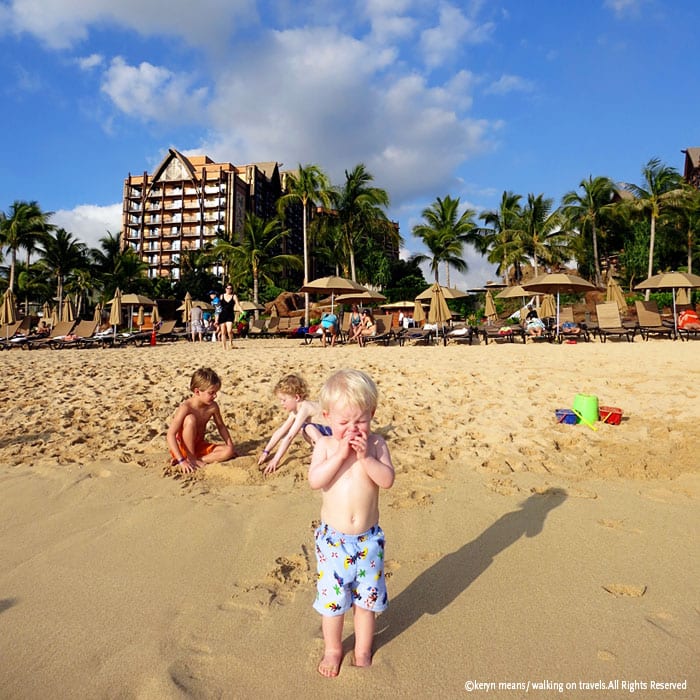
Why I understand Jet Lag with babies and Toddlers
I’ve been traveling with my boys for more than fourteen years. I’ve made so many mistakes along the way, but I have learned a lot about jet lag too. I now help friends who want to travel with babies and toddlers, whether they are visiting family, going on vacation, or have to relocate for a job.
After all of this time, and trial and error, I think I have a jet lag with babies system figured out.
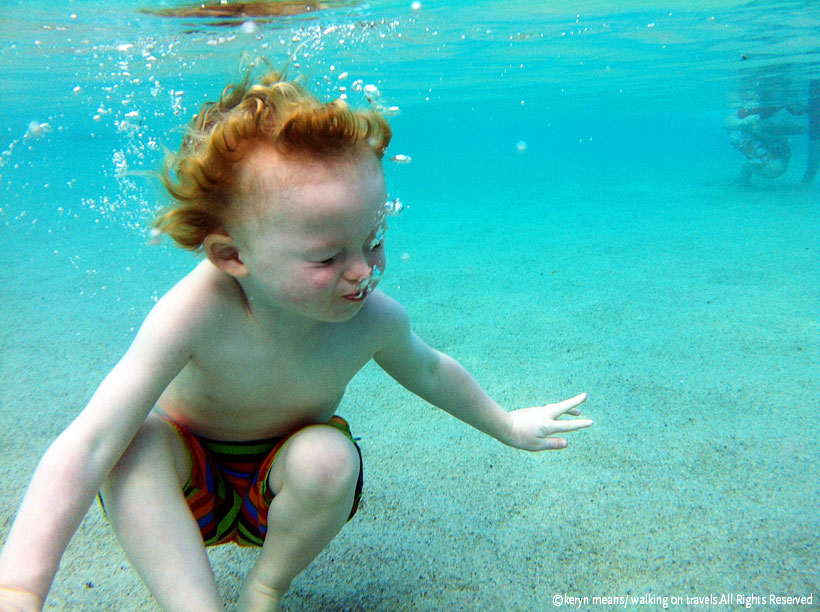
Babies and Jet Lag
When you travel alone across time zones you can trick your body into staying awake and force yourself onto local time. Babies don’t really go for this.
If it is 4am locally and 10am back home, well you better believe your baby’s jet lag will have him up even if you put him to bed at 11pm last night (local time of course).
Time to accept the reality of jet lag with babies and move on.
OK, just kidding. You need some strategies to help babies with jet lag, but first you need to know WHY your baby has jet lag.
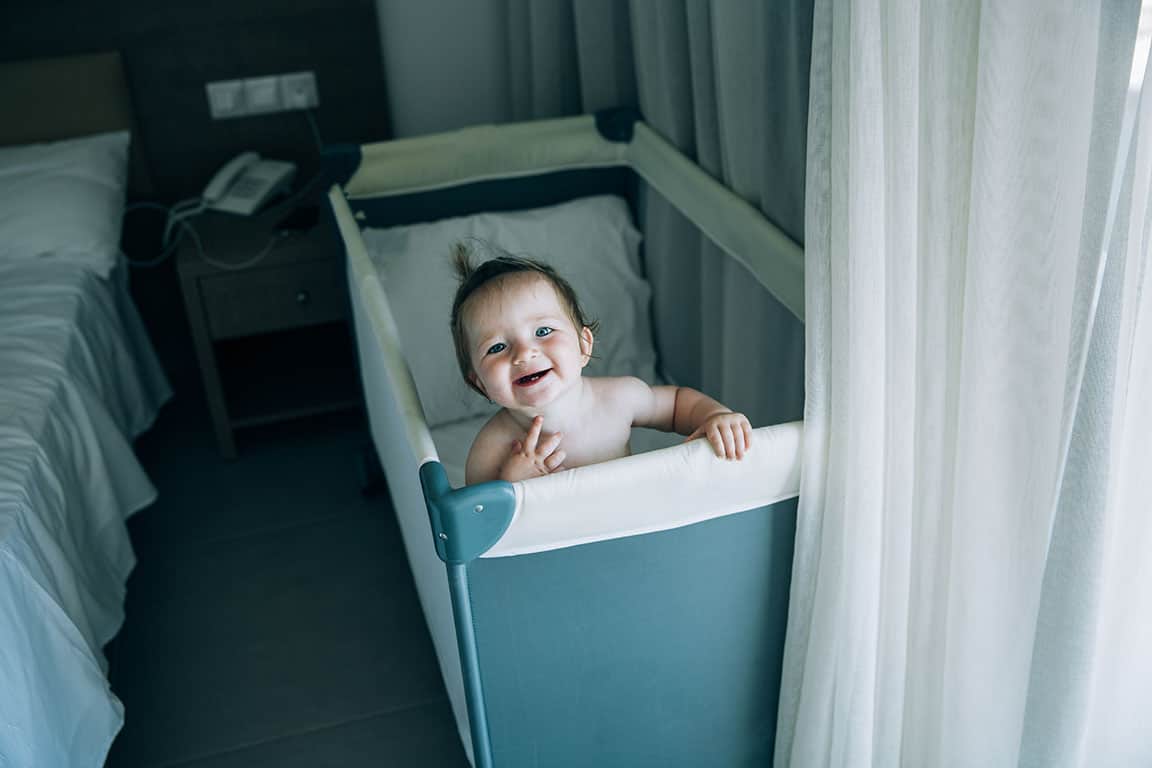
What is Baby Jet Lag?
“Baby jet lag” is a term used to describe the disruption in a baby’s sleep and feeding schedule that happens when they have traveled across multiple time zones.
It’s really no different than adults with jet lag. When parents travel with a baby to a different time zone, the baby’s internal body clock, also known as the circadian rhythm, is out of sync with the local time at the destination. Your baby is confused about when its time to eat, sleep and play.
Common symptoms of babies with jet lag
- Altered Sleep Patterns: Babies may have difficulty falling asleep at their normal bedtime according to the local clock, and could wake up earlier in the morning than they would at home.
- Irritability and Fussiness: Changes in sleep and feeding schedules can and will make your baby more cranky than usual. You could encounter a jet lag baby crying at night more than usual because his or her little body just doesn’t know what is going on.
- Feeding Difficulties: Babies might not be hungry when it’s mealtime at the destination, or they may not be as interested in food for the first few days. I panicked about this the first few times, but my pediatrician assured me it was normal and my baby would eat again when he was hungry.
- Difficulty Adjusting to New Routines: Babies may struggle to switch over to a new daily routine, which can make naps and bedtime a bit more challenging. Try to stick to your bedtime routine as closely as possible when you travel.

Common Questions about jet lag in Babies and toddlers
How can I help my baby adjust to a new time zone after a trip?
One of the biggest questions I get about jet lag in babies is AFTER a family has returned from their trip. While the jet lag might have been just as bad in the beginning of the trip that euphoria of traveling somewhere new can make any hiccup seem inconsequential.
However, when you get back home, having a baby who won’t sleep can be a parents worst nightmare, especially if you have already gone through sleep training.
Just like you do when you go to a new timezone, ease your baby in. He may be up late or want to go to bed early. Try to push it an hour each day if possible until you are back to your usual sleep schedule.
You may have to do some sleep training, but your baby has been through it once, so they will catch on quicker this time around.
What’s the best way to establish a new sleep schedule for my baby when traveling?
Just like when you got home, you will want to follow your baby’s natural need to sleep. Try to push it up (or back) an hour or more each day, skipping a nap if you really have to.
You may need to do a little sleep training when you travel, but this system is something your baby now knows and it gives him or her cues that it might just be time for a nap or bedtime.
Are there specific strategies for preventing baby jet lag before the trip?
Some people try to adjust their baby slowly to the new timezone before a trip. This means you will push back or bring forward bedtime by about an hour (or even 30 minutes) at a time.
Drastic time changes on a trip are hard, and I’ve never had much success with this, but I know parents who swear it works.
How long does baby jet lag typically last, and when can I expect my baby to adjust?
Jet lag is a funny beast. Some kids switch timezone very quickly (my youngest wakes up at 6:30am no matter where we are in the world), while others take a little more time. Babies and toddlers tend to adjust to new timezones and destinations faster than adults, so there is hope parents.
If you are doing a short range trip, meaning you are only going ahead or back one to three hours, you will probably adjust in a day or two.
If you are flying from North America to Europe, or USA to Asia, where there can be a five to 12 hour time difference, you could be looking at a few days to a week or more.
Don’t get discouraged though. Travel with babies and toddlers is still worth it!
Track your baby’s progress with our jet lag tracker.
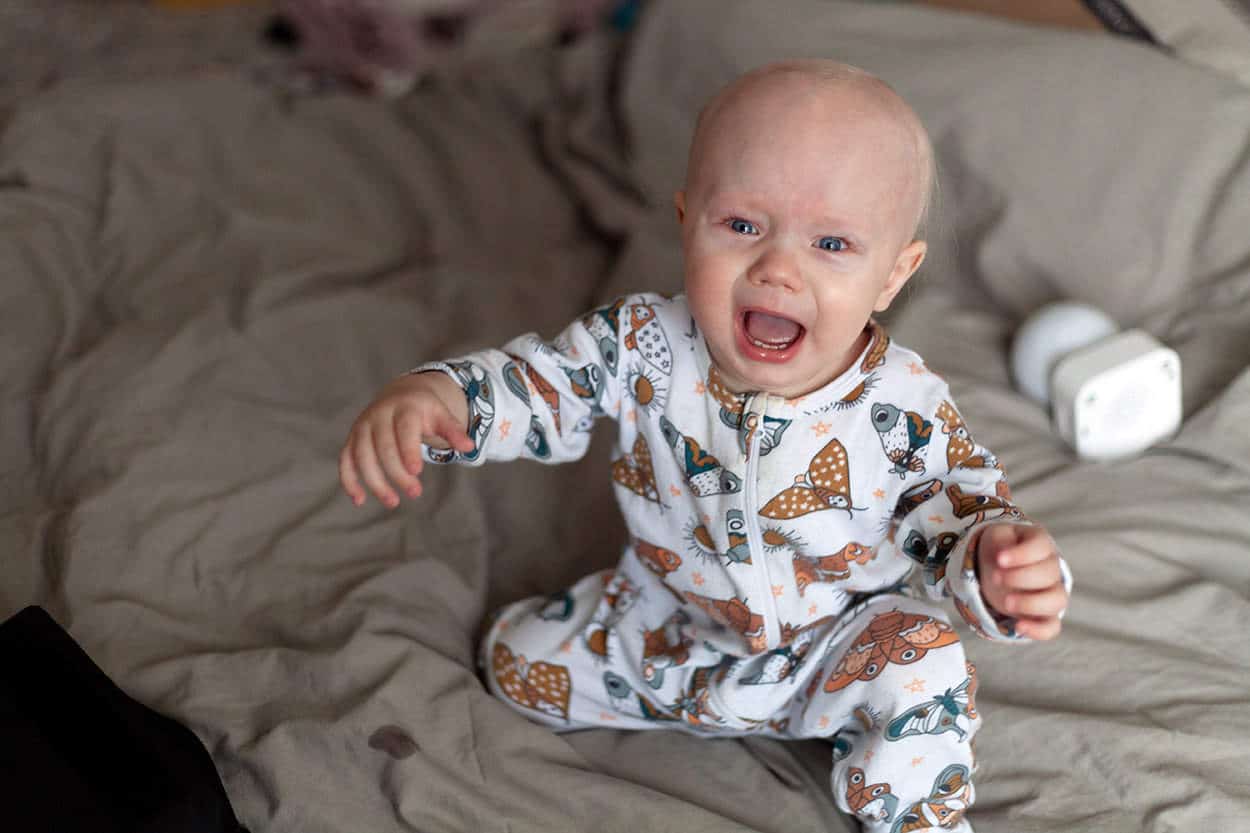
What are the best practices for preparing a baby for long-haul flights and time zone changes?
- Choose Your Flight Times Carefully: When possible, select flight times that work with your baby’s natural sleep schedule. Red-eye flights or flights during their usual nap time can help babies sleep during the journey. Keep in mind that delays and cancellations do happen, so that morning flight might turn into a red-eye and vice versa. Just be mentally prepared and do the best you can.
- Pack Essentials: Pack a well-organized diaper bag with all the essentials, including diapers, wipes, a change of clothes (for you and the baby!), baby food, formula or breast milk (if applicable), and any comfort items your baby needs. Grab our best tips for bottle feeding on a plane and breastfeeding on a plane.
- Carry on the most important friends: Never forget to pack your baby’s lovie, blanket, stuffed animal or any other familiar items that your baby always has when they sleep. Trust me, if you leave “Froggie” home, your baby will NOT fall asleep. I have ordered more frog lovies on Amazon to be delivered overnight than I care to admit.
- Book a Bassinet or Extra Seat: If your baby is under two years old and qualifies as a lap infant, consider booking a bassinet seat (no extra cost) or an extra seat for added comfort during the flight (extra plane ticket cost).
- Bring Entertainment: Pack a variety of small toys and books to keep your baby entertained during the flight. You do not have to pack the entire nursery– less is more. A Tupperware filled with small blocks is a three-in-one entertainment machine. That magazine someone left can now be torn to shreds by your baby. Chances are you will be walking the aisle a bit too, so make sure you (the parent) have comfortable shoes on.
- Dress in Layers: Dress your baby in comfortable, breathable layers to accommodate changes in temperature on the plane. Planes can be chilly, so bring a light jacket, blanket or sleep sack (like this one, which is perfect for bedtime routines on the plane too!)
- Feed During Takeoff and Landing: Nursing or bottle-feeding during takeoff and landing can help relieve pressure in your baby’s ears. If you baby takes a pacifier, this can work in a similar way. For those babies who have extra trouble with their ears, pack some baby Tylenol to help with the pain. We flew when one of my boys had the beginnings of an ear infections, but we didn’t know it, and his pacifier plus Tylenol was a lifesaver.
- Stay Hydrated: Ensure your baby stays hydrated during the flight. If your pediatrician has approved water for your baby, have it handy to give, or do some nursing and bottle feeding on demand if your baby seems more thirsty or hungry than usual.
- Maintain Your Routine: Try to stick to your baby’s usual routine as much as possible during the flight. Have meals and snacks when you would usually have them at home. If you baby usually eats every three hours, feed him or her every three hours. Keep your same bedtime routine if at all possible, or at least get as close as you can.
- Keep Calm and Be Patient: Babies can pick up on their parents’ stress, so try to stay calm and patient. Don’t worry about the other passengers. More than half of them have dealt with crying babies at some point in their lives, and well, you won’t see the other half ever again. Wear your “patience pants” onto the plane and those first few days of your trip. It’s the best armor to help you and your baby adjust. If you go in with patience, you and your baby will get over jet lag more easily.
- Adjust to Local Time: Once you arrive at your destination, start adjusting your baby to the local time zone immediately. Get outside so your baby’s body can see and feel the natural daytime light. Go to bed at the same time you do at home, but on local time (8pm back home means 8pm in your new destination). Have breakfast, lunch and dinner when you normally do, but keep in mind that a few extra snacks may be needed the first few days as your baby’s stomach adjusts.
- Consider Short Layovers: I prefer nonstop flights whenever possible, especially when traveling with a baby or toddler. If you do have to book connecting flights, try to make the layover as short as possible. If you have a long layover, and you have lounge access (your credit cards may have it as a perk), this is a great place for your baby to hang out. Sometimes there is even a play area.
- Use Travel-Friendly Gear: Do not pack every piece of travel gear you own. Leave the nursing pillow at home (hot tip: your neck pillow works just as your nursing pillow, and is way more compact), and your mega stroller. Pack a lightweight stroller (this one fits in the overhead bin on the plane!), portable crib, and baby carrier that makes navigating airports and new locations so much easier.

Are there specific travel destinations that are more baby-friendly in terms of minimizing jet lag?
The best way to minimize jet lag in babies and toddlers is to limit the number of timezones you cross. A three hour difference is easier for a baby (and parents) to handle than a 10 hour difference.
If you are nervous, stick to your timezone. If you draw a straight line down the map from where you live, you will find plenty of places to explore.
How can parents help babies sleep during a flight and adjust to a new sleep schedule upon arrival?
My tried and true method for getting infants and babies to sleep, and even my toddler before he was too big for me to carry, is to strap them into a baby carrier (front facing as much as possible), and start walking the aisles.
International flights tend to have large galleys that you can rock your baby to sleep in too. Just make sure you listen to the flight attendants if they tell you to sit down and stay out of their way.
If you baby gets some good sleep on the plane, they will more easily get to sleep when you are on vacation.
What are the potential health and safety considerations for traveling with a baby who is experiencing jet lag?
The biggest thing you need to remember when traveling with a baby who is experiencing jet lag is that they still need to sleep, eat and stay hydrated.
There are no serious health concerns when it comes to jet lag, but your pediatrician may have some suggestions that apply to your specific child’s needs.
How can parents create a comfortable and familiar sleep environment for their baby while traveling?
When you want to make a familiar sleep environment for your baby, you need to bring a few comforts from home. These don’t have to be big– I’m talking a pacifier, lovie, teddy bear, and/or a blanket that they always sleep with at home.
My boys have been sleeping with white noise since they were born. This means that as long as I pack a sound machine (this is the one we use), then they are going to sleep to the same sound no matter where we are in the world.
If you have a sleep routine at home, do it when you travel too. Bottle, bath, PJs, book and bed was always our routine.
I’ve done a sleep routine on overnight flights and it really helps. I can’t do the bath, but as my boys grew into toddlers, we went to the potty, got PJs on, read a book, I built a sleep tent on the plane in their seat, and they went to bed.
What are some effective techniques for soothing an irritable or fussy baby who is experiencing jet lag?
Comforting your baby with jet lag isn’t much different than any other time they are cranky, sad, or upset. Cuddling, rocking back and forth, snuggles in bed, a walk around the block, and even a bath are just a few of the ways you can sooth your baby.
My boys always loved a bath when they needed to chill out. Even today my youngest will take a bath when he just needs to calm his body and mind down a bit.
If your baby loves a wrap or carrier (here’s some of our favorite infant carriers), strap your baby on and take a walk together. Babies love to see new things, and chances are, wherever you have traveled there is a shape, color or sound that will fascinate them.
What do I do if I’m so tired I can’t handle my jet lag, let alone my baby’s jet lag?
The most useful parenting tip I give my friends is this– if you have a co-parent, take turns sleeping. At home my husband and I took turns on the weekend to sleep in and not be on baby or toddler duty. Generally, I got Saturdays and my husband got Sundays. This continued whenever we traveled.
The first night we might tag team to get through, but after that we each get a turn to not hide in the bathroom with the baby in the middle of the night.
Now, nursing moms stay with me– even if you have to wake up to breastfeed, you can still hand the baby back to its dad or mom to change diapers, burp, rock, and play with the baby while you go back to bed.
It’s not a perfect system, but it’s way more than you would get if you both tried to stay up with the baby.
How long does it typically take for a baby to fully adjust to a new time zone, and when should parents seek professional advice if needed?
Depending on how far you are traveling, your baby could adjust in a day or two. If you are traveling far or flipping your clock completely (12 hour time change), it may take one or two weeks to get your baby back to their usual schedule.
If you are trying all of your tried and true tricks to get your baby to sleep, whether you use the Ferber Method, Cry It Out, Chair Method, Pat Pat Shush, or whatever has worked for you in the past, and nothing is changing then you should consult your pediatrician.
If you are just stressed out and need to talk to someone to be assured everything is normal, call your pediatrician or a sleep consultant. That’s why they are there– to help you with your baby and toddler.
Need more baby jet lag tips? Check out our jet lag survival guide!
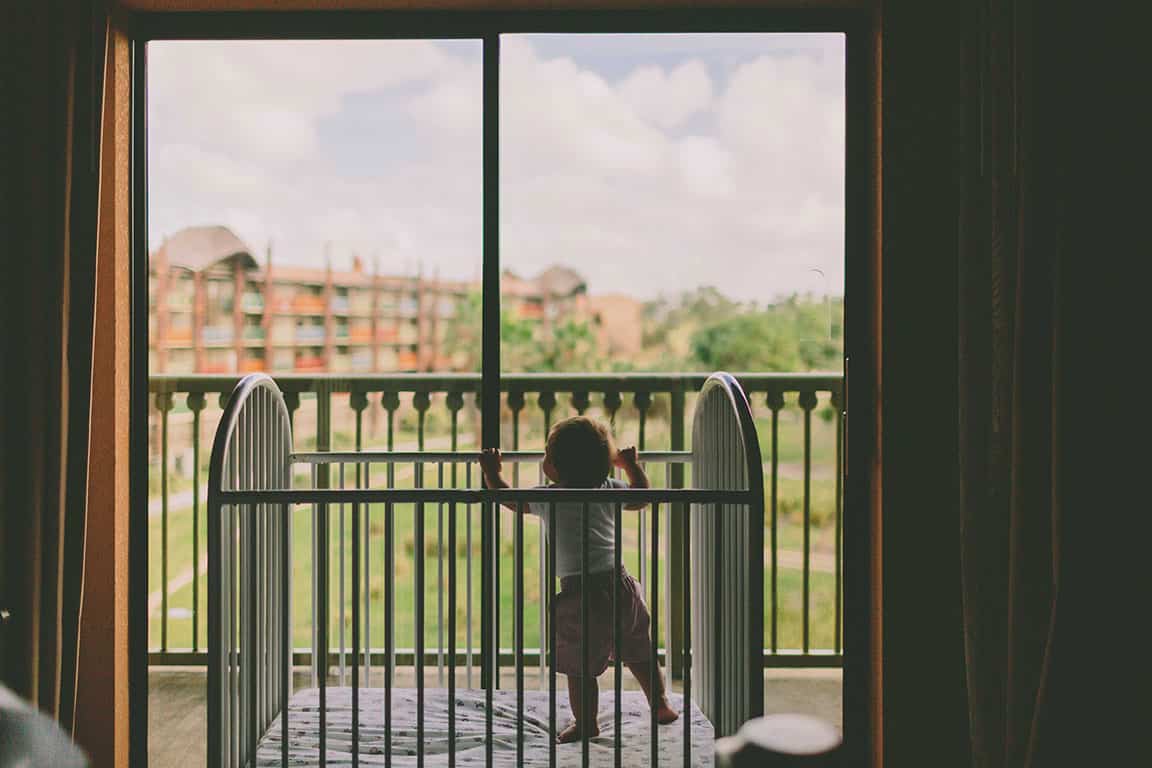
What does a Jet Lagged Baby Actually Look Like?
It’s all good to know what you should pack and learning how to get over jet lag with your baby, but what does this actually look like in reality? Here’s a look at how I have handled babies with jet lag and toddlers with jet lag the first few nights of every trip.
Go to sleep and get up with your baby
Your kids are going to wake up when you want to sleep. This is inevitable even at home when you have a baby and/or toddler.
Try to go to bed when your kids do so you can both get a few hour of sleep before your baby’s jet lag tells them it is time to wake up. Once that happens, get up. Don’t play pacifier ping pong, try to force them back to sleep or ignore it.
Just get up and deal with your jet lagged baby. Play for a bit, have some food, and pretend to be awake. You may not like it, but this is the reality of the situation.
Be Prepared with Food
As soon as you land at your destination find the local market and grab milk, yogurt and cereal, or whatever your family likes to eat first thing in the morning.
When the kids wake up at 4am give them breakfast. Don’t fight it. Don’t try to give them a glass of water and put them back to bed. Their jet lag baby bodies just told them it is time to eat. They will make you listen to their needs even if it means crying for the next four hours.
Please– feed your baby so he doesn’t cry for the next four hours. No one, especially you, wants to hear that.
Bring out the entertainment
Your baby isn’t quite ready to go to bed, no matter how tired you are right now. That bottle or snack you just gave them might have signaled their bodies that it is now morning and time to play. Here’s what you can do in a hotel room with a baby and toddler when you are up in the wee hours of the night together.
- After breakfast read a few books (this was my boys’ favorite, and I can still recite it by heart), play with the toys you brought or take a bath.
- Do something quiet that can keep your kids entertained, but will not over stimulate them.
- If you are way too tired to play a rousing game of peek-a-boo with your kid, pop on some Curious George cartoons on your Kindle Fire or another favorite show.
- Get yourself through the wee-hours of baby jet lag anyway you can.
Go back to bed
After about 1-3 hours, do your normal bedtime routine again.
Your kids are probably still in their pajamas, but you can brush their teeth, have them sit on the toilet, change diapers, read stories and have a bottle or cup of milk.
Lay the baby down in her travel crib, tuck your toddler into their portable toddler bed, and crawl back into your bed.
Now, stay very still as you pray that your kids will go back to sleep.
Chances are they will. If not, well, you may be watching the sun come up wherever you are. It’s not that bad. Sunrises are pretty awesome. I’ve seen a lot thanks to my boys.
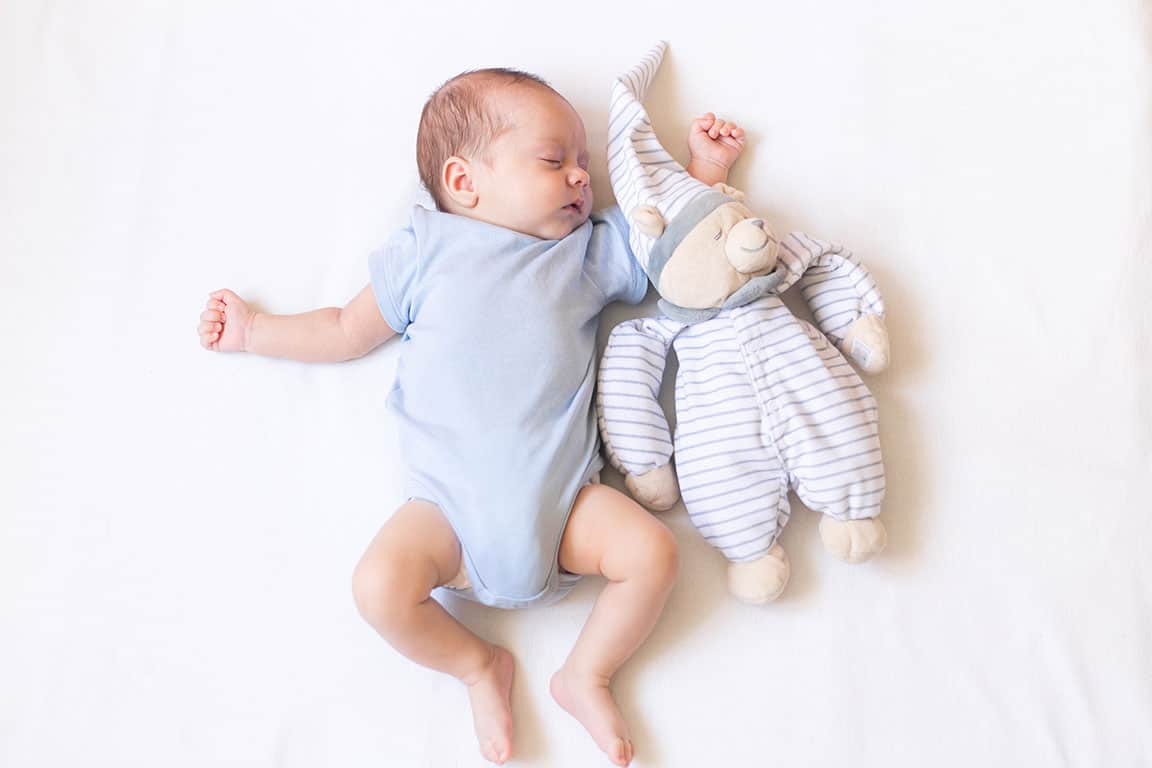
Jet Lag with Babies and Toddlers Conquered!
Once I figured out the system that worked for us and got us through jet lag, I felt better about traveling with kids. You may have a disastrous flight, or a few days of early mornings and late nights, but the best jet lag tip I’ve learned is to just go with the flow.
You may be up in Hawaii at 4:30am, and back in bed by 7am for a nice three-hour nap, and that is OK. It’s not perfect, but anything you try is better than nothing with it comes to jet lag with babies.


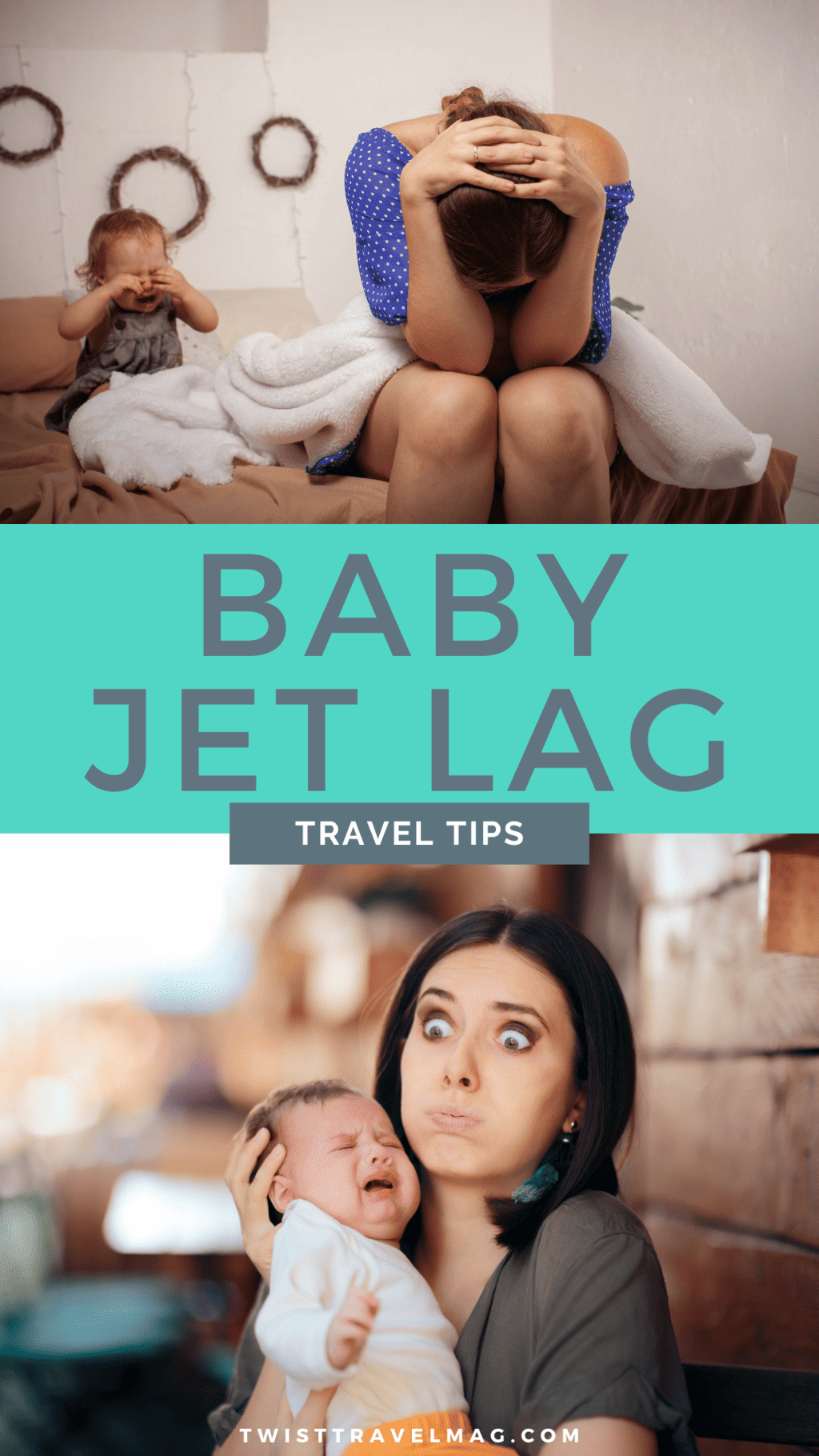
Still trying to figure out a system. Getting back into our daily routine when coming home helps. But otherwise, trying to figure out the 3am wake ups after travelling 7 hours time difference in either direction.
Yes, Europe was pretty bad for us. It took 4 days to get into the swing of things…but we managed. The Hawaiian time zone change is not very fun either…hate early mornings.
Nicole- Hawaii is just that annoying time change that throws everyone off a little bit, but still has quite the impact. I won’t stop going though 😉 Europe too. We actually did a lot better in Europe this past year. I think it helped that I had Mike with me and we could tag team.
We’ve been fortunate with our travels and the only time we have changed time zones more than an hour was when we travelled from Perth (home) to Sydney a 3 hour time difference. However as we travelled west to east we just stayed on WST who cares if our toddler was still running about the boardwalk at midnight. We just all slept in until 10am.
However travelling east to west is not so easy, nor is travelling for greater time changes. My advice: unless it’s absolutely necessary (like visiting family) try not to change time zones look for destinations North or South of your home, particularly while they are very young and don’t understand what has happened. There are so many more years of travel when they are a bit older and can understand that the time zone is different and it is just time to go to bed.
Unfortunately changing timezones has never been an option for us. All of our family lives on the east coast of the U.S., while we live on the west. From the beginning we knew jet lag would be a part of our lives. Once we accepted that we moved onto all of the fabulous places we could go. Going north or south from the west coast without changing timezones is a bit limiting. Even central and south america are 1-5 hours off from us. Boo!
Useful tips! Dealing with a time change in addition to a change in setting, bed, sleeping arrangements, climate, etc. is so much for a little one. The 6-hour time difference to Brazil has never been much of an issue, but the 15-hour time change in Bali was a struggle. After a couple of days, though, it was fine.
I hear you. It’s a struggle! Some parents say their kids don’t have jet lag, but mine definitely does. Great tips!
Make sure to get lots of sunshine during the day to adjust young bodies to the new time zone. Adjust your sleep/wake time by a few hours as necessary. SLEEP WHEN YOUR CHILD SLEEPS!
Great tips Colleen!
Thanks for the tips! Dealing with some jet lag iffues right now…5 days in on a trip from Western Canada to Sweden. Not going very well, the little one seems to only want to be awake at night and sleep all day no matter what we do. And…of course as it often is in Sweden…no sunshine to take her out to! Lol….keeping fingers crossed that she adjusts soon.
I live in Europe, and arrived a week ago after a three week visit Stateside, traveling without my husband. We didn’t have trouble in the US…it was normal jet lag. But coming back, my one year old and I have struggled and are still fighting it. I am getting desperate now. I am so thankful for my husband for letting me sleep when I need it, but I think we’re having such trouble still because my baby and I aren’t staying together. I also made the mistake of using these brilliant European blackout shutters too many naps, I am afraid. Iam finding lavender helpful to help soothe my daughter into bedtime. Thanks for the advice and support!